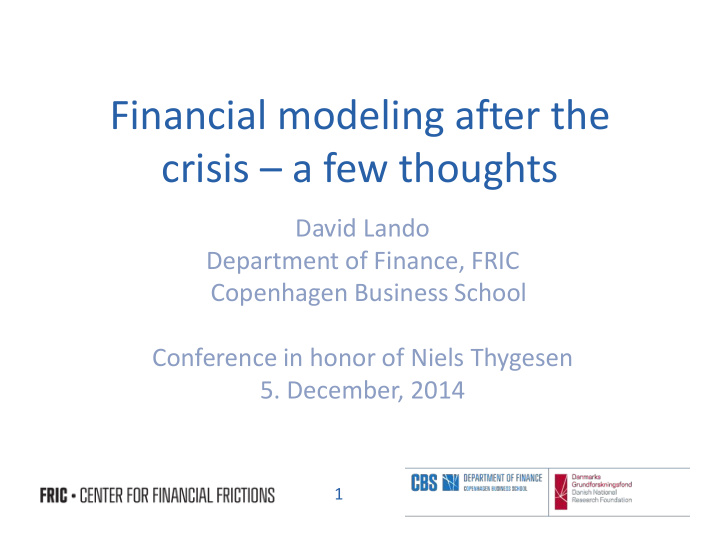



Financial modeling after the crisis – a few thoughts David Lando Department of Finance, FRIC Copenhagen Business School Conference in honor of Niels Thygesen 5. December, 2014 1
Agenda • Benchmark cases are (still) important • Institutions matter • Modern asset pricing takes frictions seriously • Concluding remarks 2
Benchmark cases are important • Efficient Market Hypothesis – Look for a rational explanation before you argue markets are irrational (and before you invest) – Look for a better model if your model does not fit • Modigliani-Miller – Please identify the friction when you argue capital structure matters for firm value, bank lending, etc. • Law of one price – Still a powerful tool! But look for frictions again when there is a breakdown 3
1-yr EURIBOR – OIS-spread • Before the crisis, a law-of- one price equates the two • The argument assumes interbank credit risk is negligible, and that there is no reluctance to give up liquidity • Both assumptions break down – but existing tools can factor in both credit risk and hoarding 4
Benchmark cases are important • Understanding the deviations from the benchmarks means taking institutions and markets seriously • One can build models with structural breaks and everything: (𝑄 𝜄 ) 𝜄∈Θ knows no limits • But hard to justify a ‘wild’ assumption without an institutional argument – why would EUREPO – OIS suddenly jump to a new regime? • The ‘first order’ shortcomings of our models have not been in our toolbox, but in abstracting away – and failing to see – changes in institutions and market practices 5
Leverage and maturity mismatch • Few (if any) realized the simultaneous build-up and vulnerability arising from – Undrawn loan commitments – Subprime mortgages – Credit and liquidity guarantees for ABCP conduits – Repo (changes in haircuts) – Wholesale funding – Margin calls on derivatives – …and more 6
Undrawn loan commitments • Off-balance sheet commitments are brought on balance sheet • CP issuers shift to existing credit lines • Non-financial businesses draw from credit lines to have cash Source: Strahan (2012) 7
The dry-up in US ABCP Source: Acharya, Schnabl and Suarez (2013) 8
Repo run because of haircuts Source: Gorton and Metrick (2012) 9
The newer models take into account • That trading requires capital, and therefore the law of one price may break down due to capital constraints of arbitrageurs, or because of counterparty credit risk • The role of counterparty credit risk • That the price of an asset or derivative is affected by its haircut in repo transactions and its margin requirements • That liquidity and liquidity risk affect the price of an asset • That there are leverage constraints • …and many other features that are rooted in the institutional and regulatory setting 10
Effect of funding illiquidity • Y-axis shows a measure of illiquidity • Higher value means more illiquid • Graph compares average illiquidity for bonds underwritten by Bear Stearns, Lehman and others Source: Dick-Nielsen, Feldhütter, Lando (2012) 11
Concluding remarks • We have not reached the limits of our toolbox • Our first order challenge is to better capture the role of institutions, regulation, frictions • Our models inform us about what data to gather and what imbalances to look for • It may matter less to which degree these imbalances are caused by rational or irrational agents 12
Literature • V. Acharya, P. Schnabl, and G. Suarez: Securitization without risk transfer Journal of Financial Economics , 2013, pp. 515-536 • J. Dick- Nielsen, P. Feldhütter and D. Lando: Corporate bond liquidity before and after the onset of the subprime crisis . Journal of Financial Economics, 2012, pp. 471-492 • N. Garleanu and L. Pedersen: Margin-based asset pricing and deviations from the law of one price. Review of Financial Studies, 2011, pp. 1980- 2022 • G. Gorton and A. Metrick: Securitized banking and the run on repo. Journal of Financial Economics, 2012, pp. 425-451 • P. Strahan: Liquidity risk and credit in the financial crisis. FRBSF Economic Letter. 2012. 13
Recommend
More recommend